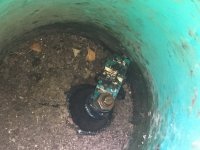GS_Texas
New Member
For two weeks now, our house water pressure oddly drops briefly, then returns to normal. This started after returning from a trip (about a month of no use). Video (https://tinyurl.com/y9oybl5c)
We have city water. About 1 year ago, we called a plumber to adjust our low water pressure; the plumber adjusted the pressure regulating valve (it’s in the ground located right after mains shut off - no basement). I think we got around 60psi after the plumber and was happy.
These days, my water pressure gauge reads 60, 70, or 80 psi (checked at two exterior faucets). You could see the same drop off and return to normal in those faucets too. Video (https://tinyurl.com/y88g6q4f)
I called our city water authority (travis county, Texas), they checked and said we should have 50psi at our mains and that we are lucky to have 60psi or more.
My question is: Does this sound like a pressure regulating/reducing valve issue?
Thanks, G.S.
We have city water. About 1 year ago, we called a plumber to adjust our low water pressure; the plumber adjusted the pressure regulating valve (it’s in the ground located right after mains shut off - no basement). I think we got around 60psi after the plumber and was happy.
These days, my water pressure gauge reads 60, 70, or 80 psi (checked at two exterior faucets). You could see the same drop off and return to normal in those faucets too. Video (https://tinyurl.com/y88g6q4f)
I called our city water authority (travis county, Texas), they checked and said we should have 50psi at our mains and that we are lucky to have 60psi or more.
My question is: Does this sound like a pressure regulating/reducing valve issue?
Thanks, G.S.

